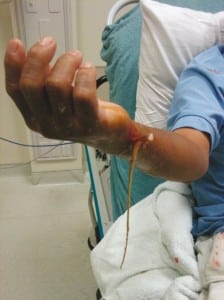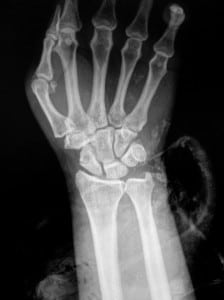| Author | Affiliation |
|---|---|
| Adele E Tse, MD | Eastern Virginia Medical School, Department of Emergency Medicine, Norfolk, Virginia |
| David P Evans, MD | Eastern Virginia Medical School, Department of Emergency Medicine, Norfolk, Virginia |
| Francis L Counselman, MD, CPE | Eastern Virginia Medical School, Department of Emergency Medicine, Norfolk, Virginia |
A 43-year-old man presented to the emergency department after he was swimming in the ocean and felt a sudden sting followed by a burning pain and muscle spasms in his right hand. Physical exam was remarkable for tachycardia and the foreign body (Figure 1). Radiograph of his right wrist is also shown (Figure 2).


DIAGNOSIS
Stingray envenomations: Stingrays are a cartilaginous bottom-dwelling fish with a hard tail and 2 or more hard barbs, each containing a venom sac. Commonly, envenomation occurs when the victim unintentionally steps on a buried stingray and reflexes cause the ray to lash out with its tail. The venom has vasoconstrictive properties, causing possible necrosis and poor wound healing. Common presentations include local pain, muscle cramps, vomiting, and diarrhea, and rare complications include artery laceration and compartment syndrome. Since the venom is heat sensitive, immediate management includes irrigation and soaking the wound in hot water (110 to 115°F) for 30 to 90 minutes to inactivate the protein.1 A radiograph should be obtained of the area to evaluate for embedded spines. One must be careful when removing the serrated spine. The best strategy is to open the wound with a scalpel along the nonjagged edges of the spine without disturbing the barbs. These wounds are to be closed by delayed primary closure. According to 1 study, due to the rate of infection, these patients are to be started on a quinolone and updated on tetanus.2
Footnotes
Supervising Section Editor: Sean Henderson, MD
Submission history: Submitted August 10, 2011; Accepted August 22, 2011
Reprints available through open access at http://escholarship.org/uc/uciem_westjem
DOI: 10.5811/westjem.2011.8.6878
Address for Correspondence: David P. Evans, MD
Eastern Virginia Medical School, Department of Emergency Medicine, Rm 304,Raleigh Building, 600 Gresham Dr, Norfolk, VA 23507
E-mail: evansdp@me.com
Conflicts of Interest: By the WestJEM article submission agreement, all authors are required to disclose all affiliations, funding, sources, and financial or management relationships that could be perceived as potential sources of bias. The authors disclosed none.
REFERENCES
1. Guenin DG, Auerbach PS. Trauma and envenomations from marine fauna. In: Tintinalli JE, Stapczynski S, Cline DM, editors. Emergency Medicine: A Comprehensive Study Guide7th ed. New York, NY: McGraw-Hill;; 1996. 868 pp.873 pp.
2. Clark RF, Girard RH, Rao D, et al. Stingray envenomation: a retrospective review of clinical presentation and treatment in 119 cases. J Emerg Med. 2007;33:33–37. [PubMed]


